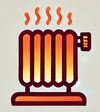Lubricating your blower motor is essential for optimal performance and longevity. Regular lubrication helps reduce friction, prevents overheating, and minimizes wear on the motor’s components. It’s best to use a high-quality lubricant specifically designed for electric motors to ensure proper function.
Neglecting this crucial maintenance step can lead to decreased efficiency and even costly repairs. By incorporating routine lubrication into your maintenance schedule, you can keep your blower motor running smoothly and extend its lifespan. Taking this simple step can save you time and money in the long run.
Blower Motor Lubrication Overview
Understanding blower motor lubrication is vital for maintaining your HVAC systems. Proper lubrication can improve efficiency and extend the life of your motor significantly.
Importance of Lubrication
Lubrication is essential for optimal motor performance. It prevents overheating and wear. When moving parts experience friction, they can heat up rapidly. This heat leads to degradation and possible failure. Regular lubrication keeps components cool and reduces wear on bearings and shafts. A well-lubricated motor operates more efficiently, which cuts energy costs in the long run. Neglecting this maintenance could result in costly repairs or complete motor replacement.
Common Lubrication Types
Different types of lubricants serve specific purposes. Here are some common options:
- Oil-Based Lubricants: These lubricants work well for high-speed applications. They penetrate surfaces easily and create a thin film to reduce friction.
- Grease-Based Lubricants: Grease stays in place longer than oil. It’s ideal for vertical applications or where there are significant loads.
- Synthetic Lubricants: These offer superior performance in extreme temperatures. They provide excellent protection against wear and tear, extending motor life.
Selecting the right lubrication type is crucial. Consider the motor’s operational conditions and manufacturer recommendations. Using the appropriate lubricant ensures long-lasting and efficient operation of your blower motor.
Steps for Effective Blower Motor Lubrication
Lubricating a blower motor enhances its efficiency and extends its life. Following these steps ensures effective lubrication.
Preparing the Blower Motor
- Locate the Blower Motor:
Find the blower motor, usually situated in a compartment below the burner in a furnace. It’s commonly known as a “squirrel cage.” - Access the Motor:
If you have an older furnace, the blower motor may mount on the side. In this case, loosen the set screw, and unscrew the bolts to detach the motor from its housing. - Clean the Motor and Fan:
Use a brush or compressed air to remove dust and dirt from the fan and motor. Clear away excess grease around the fittings for a clean surface. - Identify Lubrication Points:
Locate the oil ports on the motor’s shaft. These are critical areas for applying lubricant.
- Select the Right Lubricant:
Choose a high-quality lubricant designed for electric motors. This helps maximize performance and longevity. - Use a Proper Application Tool:
Use an oil can or a syringe for precise application. This ensures you’re applying the right amount without over-lubricating. - Apply Lubricant Carefully:
Insert the applicator into the oil ports. Apply a few drops of lubricant to each port and avoid excessive amounts. - Wipe off Excess Lubricant:
Clean any excess lubricant that seeps out. This prevents buildup, which can attract dirt and dust. - Reassemble the Motor:
Once lubrication is complete, reattach the motor to its housing. Ensure it is secure to prevent vibrations during operation.
Following these steps enhances your blower motor’s performance. Regular maintenance generates smoother operation and extends the lifespan of your HVAC system.
Signs of Lubrication Issues
You may notice specific signs indicating lubrication problems in your blower motor. Recognizing these signs promptly can prevent larger issues down the line.
Noise and Vibration
Unusual noises and vibrations often signal lubrication troubles. You might hear:
- Squealing or Screeching Sounds: These noises suggest that the bearings are worn or lack adequate lubrication. Lubricating or replacing the bearings usually resolves this issue.
- Unsteady or Excessive Vibration: Increased vibration can indicate that the motor is struggling. Proper lubrication can stabilize performance.
Overheating Concerns
Overheating presents a significant risk for blower motors. If your motor gets too hot, watch for these signs:
- Hot to the Touch: If the motor feels excessively warm, it may indicate insufficient lubrication. Keeping the bearings lubricated helps maintain a safe operational temperature.
- Burnt Odor: You might notice an acrid smell. This odor often signals overheating, which can lead to permanent damage. Adequate lubrication can help avoid this scenario.
Pay attention to these signs. Regular maintenance, including lubrication, keeps your blower motor running smoothly and efficiently. Recognizing issues early can save you from costly repairs.
Choosing the Right Lubricant
Choosing the right lubricant is vital for your blower motor’s performance. The wrong lubricant can lead to damage and decreased efficiency. Here’s what you need to know.
Types of Lubricants Available
- Oil-Based Lubricants:
Oil-based lubricants work well for older blower motors, especially those with belt-driven systems. Look for mineral or synthetic oils like ISO 68 or ISO 150 PAO synthetic oils. Match the oil type to your motor’s speed and load for best results. - Grease-Based Lubricants:
Grease is the most common option for blower motor bearings. Consider polyurea-based greases like Mobile Polyrex EM. These are recommended for electric motor bearings and pillow blocks. Avoid mixing them with lithium complex greases, as this can reduce effectiveness.
Choose lithium-based greases when moisture resistance or high centrifugal forces are a concern. They perform well in fan bearings under such conditions.
- Motor Specifications:
Always refer to your blower motor’s specifications. Manufacturer recommendations guide the right lubricant choice. Different motors require different lubrication types. - Operating Conditions:
Assess the environmental factors surrounding your motor. High humidity or extreme temperatures can affect lubricant performance. Select a lubricant that can withstand these conditions. - Maintenance Frequency:
Consider how often you maintain your system. Regularly check lubricant levels and replace as needed. This helps maintain optimal motor function. - Application Method:
Use the proper tools for lubricant application. Precise application minimizes waste and ensures effective coverage. Avoid over-lubricating, as excess can attract dirt and debris.
Choosing the right lubricant is key for longevity and efficiency. Pay attention to the specific needs of your blower motor, and your efforts pay off with smoother operation.
Conclusion
Maintaining your blower motor with proper lubrication isn’t just a task; it’s essential for ensuring efficiency and longevity. By staying proactive with lubrication, you can avoid costly repairs and enhance the performance of your HVAC system. Choosing the right lubricant tailored to your motor’s specifications will make a significant difference.
Pay attention to any signs of lubrication issues, as early detection can save you from bigger problems down the line. Incorporating regular lubrication into your maintenance routine is a smart investment that pays off in smoother operation and reduced energy costs. Keep your blower motor running at its best and enjoy the benefits of a well-maintained system.








